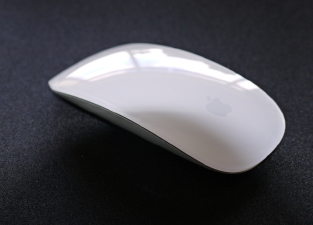
Apple's Magic Mouse brings multi-touch features to the desktop
Apple’s history of mouse making comes with a few hits and many misses. The Mac and iPod maker’s insightful design and legendary ease of use fails to translate to their wired and wireless mouse design. While their notebook trackpads are considered the best in the business, the desktop counterparts leave much to be desired.
Apple, after all, was behind the creation of such oddities as the unmanageable hockey-puck mouse, the transparent and dirt-attracting Apple Mouse and the recently discarded Mighty Mouse, whose miniscule scroll ball was notorious for gooping up with dust and dirt. That, plus Apple’s stubborn refusal to add a right-click button, hasn’t made their mice very popular but this may magically change.
Their recently released Magic Mouse, which ships free with every new iMac or Mac Pro or can be bought standalone for a spendy $69.99. This is a uniquely designed Bluetooth powered, multi-touch mouse that builds on the iPhone’s touch-centric ease of use. Redesigned to integrate the form factor of a wireless mouse with half the functionality of trackpad, the Magic Mouse pushes the boundaries of what a mouse can accomplish.
One of the few Apple devices (together with the Mac Mini and the MacBook) that still sports the glossy white Lucite and aluminum finish, the Magic Mouse is curvaceous, shiny affair that sports an unusual scalloped shape that makes it look almost like half a regular mouse. Everything about it feels expensive; we’re surprised it didn’t ship in a felt-lined box. It looks good too; no sharp edges or awkward gaps are to be found anywhere. This thing looks like it was designed in a wind tunnel.
Photo courtesy of Apple Inc.
Apple’s obsession with having only one button in its devices reaches a new level of divinity with the Magic Mouse, which is essentially one big button. The ability to right-click, swipe, scroll up; down and sideways is done through multitouch with one, two or three finger combinations.
Scrolling with momentum is particularly useful feature when dealing with long webpages or documents. This feature allows you to vary the scrolling speed with by the amount of force you apply on the surface. It comes in handy when using the CoverFlow style of navigation where images and files are presented on a horizontal strip.
Multitouch functionality on the Magic Mouse is really useful, especially when using software that allows these sleight of hand gestures but you will quickly miss the secondary buttons that enable special features such as the Mac’s Exposé function that gives you access to all the open windows with one click. One feature that is in Apple track pads and the iPhone but missing in the Magic Mouse is the pinch-to-zoom and rotation features. It remains to be seen if this will be added later on.
While mousing around, we did find the tracking action to be a bit too slow, sluggish even. This is despite setting it at the highest possible speed. Here’s hoping that future software updates will turbocharge the Magic Mouse because while it looks fast, it most definitely isn’t.

Our advice is for anyone interested in the Apple Magic Mouse to give it a try before buying it. The device impressed us at first but soon felt it didn’t deliver all the features and functionality we expected. Ideally it should work like a trackpad does where you navigate with your finger without having to lift the whole mouse around. This should at least be an option.
The big caveat here is that the Magic Mouse is limited to work on Macs with Leopard and Snow Leopard OS. So Windows and Linux users as well as Mac users on older operating systems without Bluetooth are sadly out of luck unless they are prepared to flex their hacking muscles or spend extra for a USB Bluetooth add on.
For Windows XP and Windows 7 users, all you need to do is install Magic Mouse drivers craftily extracted via WinRar resulting in a 32bit version and a 64bit version that you can install on any ordinary Windows PC that will enable all the scrolling ‘magic’ of the Magic Mouse. Note however that using the Magic Mouse on anything but a recent Snow Leopard enabled Mac is not supported by Apple so you are pretty much on your own.
The deal breaker, aside from the price, is the lack of zip and snappiness of the mouse itself. Bluetooth mice are also notorious for connectivity issues which explains why there are so few of them running around in the market today. If we got one free with a new Mac we’d probably use it but we wouldn’t go out of our way to buy one otherwise.
Rating 3.5 out of 5



